List of flags and coats of arms of the provinces of Prussia
The list of flags and coats of arms of the provinces of Prussia shows the flags and coats of arms of the Prussian provinces . The flags as shown below were used as the civil flag ( national colors ). Official flags also showed the coat of arms of the province in the center.
With the revolution of 1918 and the transformation of the Prussian monarchy into the republican Free State of Prussia , many coats of arms were changed and monarchist symbols were removed. In 1935 all flags of the provinces of Prussia, as well as the flags of the other German countries, were abolished.
According to a decree of the Prussian State Ministry of February 28, 1881, all coats of arms of the twelve Prussian provinces showed in their "Great Coat of Arms" a wild man and a knight as a shield holder . The wild man always holds a lance with a pennant in his right hand, which shows the little coat of arms of Prussia , the knight repeats the coat of arms of the respective province in the same way.
Since the coats of arms of the provinces differed only in the escutcheon and the helmet , the escutcheon is listed here in a separate column. It is mostly based on the coats of arms of the historical territories that formed the state of Prussia.
The colors of the provincial flag are usually derived from the coat of arms. According to the rules of heraldry , the color of the common figure (such as the heraldic animal ) comes before the field color . That is why the flag of Brandenburg is red and silver (and not the other way around), since the red of the Märkischer Adler takes precedence over the silver field.
| Name and location | flag | Heraldic shield | Great coat of arms | Remarks |
|---|---|---|---|---|
Brandenburg
|

|

|

|
The flag was officially adopted on October 22, 1882.
The coat of arms of Brandenburg, the red Märkische eagle on a silver background, dates from the 12th century and is also used by today's state of Brandenburg . The eagle on his chest to commemorate carried Decree of 11 January 1864 Rabsaris -Würde the dissolved Holy Roman Empire, located BEEN in electoral and royal coat of arms golden kingdom scepter in the blue box, the eagle breastplate be launched. |
Hanover
|

|

|

|
The flag was officially introduced by King Ernst August I of Hanover on July 22, 1837. After the annexation, Prussia adopted this flag for its province on October 22, 1882.
The coat of arms of the province, like that of the province of Westphalia, showed on a red background the silver saxony horse, which goes back to the Welfs . Today's state of Lower Saxony continues to use the coat of arms. |
Hessen-Nassau
|

|

|

|
The flag was officially adopted on October 22, 1882. Its colors, from top to bottom, were red-white-blue, identical to the flag of the Netherlands . The Duchy of Nassau was the ancestral home of the Dutch royal family .
The coat of arms is divided into three parts and shows the coats of arms of the three annexed states: on the right (seen from the bearer) the crowned, silver and red divided (but mirror-inverted) "colorful" lion of the Electorate of Hesse , on the left a crowned golden lion, like the first in the blue Field, for the Duchy of Nassau , in the red tip the gold-armored silver eagle of the Free City of Frankfurt . The lion coat of arms and the red and white flag, which are common in the Electorate, are again the insignia of the state of Hesse . The silver imperial eagle on a red background has been the city coat of arms of Frankfurt am Main since the Middle Ages , the Nassau lion can be found in the coats of arms of some districts. |
Hohenzollern country
|

|

|

|
The flag was officially adopted on October 22, 1882. |
Lower Silesia
|

|

|

|
The flag of Silesia was officially adopted for the Province of Silesia on October 22, 1882 . In 1920 it was reintroduced for the new province of Lower Silesia and remained in use until 1935.
The coat of arms is identical to the coat of arms of Silesia . Since the sub-province was only formed after the founding of the republic, the coat of arms lacks monarchist attributes, i. H. the eagle does not wear a ducal crown . The present-day Polish Voivodeship Lower Silesia also uses this coat of arms. |
Upper Silesia
|

|
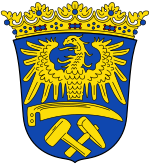
|
The flag of Upper Silesia is derived from the coat of arms of Upper Silesia. It was officially in use between 1920 and 1935.
The Upper Silesian coat of arms goes back to the Dukes of Opole and shows a gold-armored, golden eagle on a blue background. The coat of arms has been in this color scheme since the 14th century. With the establishment of the Prussian province of Upper Silesia, a new coat of arms became necessary, designed by Otto Hupp and officially adopted on June 1, 1926. The coat of arms shows half an uncrowned Upper Silesian eagle on a blue background, in the middle a yellow scythe and underneath, also in yellow, mallets and iron . The coat of arms takes on characteristic Upper Silesian motifs, such as the Piast eagle, the scythe representing agriculture and the crossed hammers as a symbol for mining , but at the same time, with the half eagle, it indicates the division of Upper Silesia in 1922. Today's coat of arms of the Silesian Voivodeship shows the uncrowned Upper Silesian eagle in contrast to that of the Opole Voivodeship . |
|
East Prussia
|

|

|
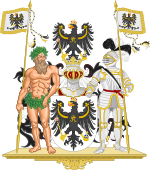
|
The flag was officially adopted on October 22, 1882 and showed the old Prussian colors, which came from the Teutonic Order. It was also the flag of the State of Prussia.
The coat of arms of East Prussia, the Kingdom of Prussia , corresponded to the coat of arms of the State of Prussia until 1920. The East Prussian coat of arms showed the crowned Prussian eagle with the royal monogram “FR” (“Fridericus Rex”) on the breast shield, which holds a scepter and orb and goes back to the imperial eagle used by the Teutonic Order since the 13th century (albeit one-headed) . Since the provincial and Prussian coats of arms were the same, the two shield holders also carried the same flags. |
Pomerania
|

|

|

|
The flag was officially adopted on October 22, 1882.
The coat of arms of Pomerania shows a gold-armored red griffin in a silver field , the symbol of the griffin dukes of Pomerania, introduced in the 12th century, which died out in the 17th century . Unlike the dukes, the province used an uncrowned heraldic animal. The present-day Polish West Pomeranian Voivodeship uses a practically identical coat of arms; the coat of arms of Mecklenburg-Western Pomerania is shared by the Pomeranian griffin with the Mecklenburg bull's head. |
Poses
|

|

|
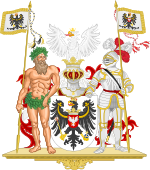
|
Between 1815 and 1886 the Grand Duchy of Poznan (province from 1849) used a two-tone, horizontal flag in red and white. The new white, black and white flag was officially adopted on November 9, 1886. |
Grenzmark Posen-West Prussia
|

|

|
The flag is a combination of the flags of West Prussia and Poznan. It was officially adopted on September 9, 1923. | |
Rhine Province
|

|
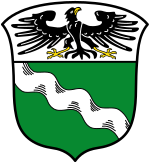
|

|
The flag was officially adopted on October 22, 1882. The coat of arms shows a slanting silver wave bar in a green field and above it in a silver shield head a soaring black eagle with a golden beak and golden fangs .
Today's coat of arms of North Rhine-Westphalia also contains the silver wavy bar on a green background as a symbol for the Rhenish part of the country. |
Saxony
|

|

|
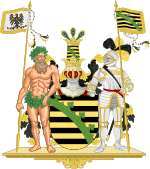
|
The flag uses the colors of the coat of arms of Saxony black and yellow. The state parliament adopted the flag on March 5, 1884, and Kaiser Wilhelm I confirmed it on April 28, 1884.
Under a silver shield head with a left-facing, gold-armored black eagle, the coat of arms shows a semicircular shield divided nine times by gold and black, covered with the right-angled green diamond-shaped wreath and was approved by the Prussian State Ministry on June 27, 1927 |
Silesia
|

|

|

|
The flag of Silesia was officially adopted for the Province of Silesia on October 22, 1882 . In 1920 it was reintroduced for the new province of Lower Silesia and remained in use until 1935.
The coat of arms of Silesia shows on a gold background a gold-armored black eagle looking to the right (seen from the wearer). He wears a white crescent moon with a cross on his chest. The coat of arms goes back to the Silesian Duke Heinrich II. (R. 1238-1241). During the monarchy the eagle wore the ducal hat , after the establishment of the Weimar Republic it was uncrowned. |
Schleswig-Holstein
|

|

|
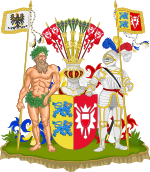
|
The flag of Schleswig-Holstein was created in the 1830s when the German movement, which turned against Danish supremacy, was not officially adopted while it was part of Prussia. Even in the Weimar Republic, it did not receive any official status, but it was widely used by the population. |
Westphalia
|
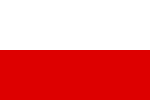
|

|

|
The Westphalia flag was officially adopted on October 22, 1882.
The coat of arms of the province, like that of the province of Hanover , showed on a red background the silver saxony horse, which goes back to the Welfs . In this form, also known as the Westphalian horse, the steed has its tail raised in a way that differs from the Lower Saxon form. Today's coat of arms of North Rhine-Westphalia also contains the jumping Westphalia horse in the red field as a symbol for the Westphalian part of the country. |
West Prussia Province
|

|

|

|
The flag was officially adopted on November 9, 1886 and remained in use until 1920. |
Individual evidence
- ↑ The coat of arms of the state of Saxony-Anhalt ( page no longer available , search in web archives ) Info: The link was automatically marked as defective. Please check the link according to the instructions and then remove this notice. (PDF brochure of the state government of Saxony-Anhalt)
See also
- Flag of Prussia
- Flag of Germany
- List of flags of German countries
- List of flags of all of Germany
- List of flags of the German Empire